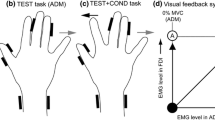Abstract
A sitting person has been exposed to transcranial magnetic stimulation (TMS) of the primary motor cortex shortly before and during increasing anticipatory grip force, while an object was falling into a cup held between the thumb and index finger of the subject. Comparison of the changes in the electrical activity of adductor pollicis brevis and the first dorsal interosseous muscles and of TMS response in these muscles revealed, on the one hand, a strong increase in TMS response not long before enhancement of muscle activity and, on the other hand, an insignificant increase in the response amplitude during substantial increase in muscle activity. An increase in the TMS response prior to initiation of motor activity suggests that the excitability of the primary motor cortex is enhanced due to specific processes caused by the direct involvement of the cortex in the programming of motor activity.
Similar content being viewed by others
References
Belen’kii, V.E., Gurfinkel’, V.S., and Pal’tsev, E.I., The Elements of Regulation of the Voluntary Movements, Biofizika, 1967, vol. 12, no. 1, p. 135.
Hugon, M., Massion, J., and Wiesendanger, M., Anticipatory Postural Changes Induced by Active Unloading and Comparison with Passive Unloading in Man, Pflugers Arch., 1982, vol. 392, p. 292.
Viallet, F., Massion, J., Massarino, R., and Khalil, R., Coordination between Posture and Movement in a Bimanual Load Lifting Task: Putative Role of a Medial Frontal Region Including the Supplementary Motor Area, Exp. Brain Res., 1992, vol. 88, p. 674.
Massion, J., Ioffe, M., Schmitz, C., et al., Acquisition of Anticipatory Postural Adjustments in a Bimanual Load Lifting Task: Normal and Pathological Aspects, Exp. Brain Res., 1999, vol. 128, p. 229.
Gurfinkel’, V.S. and El’ner, A.M., Involvement of the Secondary Motor Region of the Anterior Lobe in Arrangement of Postural Components of Voluntary Movement in Man, Neirofiziologiya, 1988, vol. 20, p. 7.
Barker, A.T., Jalinous, R., and Freeston, I.L., Non-Invasive Magnetic Stimulation of the Human Motor Cortex, Lancet, 1985, vol. 1, p. 1106.
Baker, S.N., Olivier, E., and Lemon, R.N., Recording An Identified Pyramidal Volley Evoked by Transcranial Magnetic Stimulation in a Conscious Macaque Monkey, Exp. Brain Res., 1994, vol. 99, p. 529.
Flament, D., Goldsmith, P., Buckley, J.C., and Lemon, R.N., Task-Dependence of Responses in First Dorsal Interosseous Muscle to Magnetic Brain Stimulation in Man, J. Physiol., 1992, vol. 464, p. 361.
Turton, A. and Lemon, R.N., The Contribution of Fast Corticospinal Input to the Voluntary Activation of Proximal Muscles in Normal Subjects and in Stroke Patients, Exp. Brain Res., 1999, vol. 129, p. 559.
Lavoie, B.A., Cody, F.W., and Capaday, C., Cortical Control of Human Soleus Muscle during Voluntary and Postural Activities Studied Using Focal Magnetic Stimulation, Exp. Brain Res., 1995, vol. 103, p. 97.
Lemon, R.N., Johansson, R.S., and Westling, G., Corticospinal Control during Reach, Grasp and Precision Lift in Man, J. Neurosci., 1995, vol. 15, p. 6145.
Johansson, R.S. and Westling, G., Roles of Glabrous Skin Receptors and Sensorimotor Memory in Automatic Control of Precision Grip When Lifting Rougher or More Slippery Objects, Exp. Brain Res., 1984, vol. 56, p. 550.
Kazennikov, O.V. and Lipshits, M.I., Influence of Preliminary Information about the Mass on Anticipatory Muscle Activity during the Catching of a Falling Object, Fiziol. Chel., 2010, vol. 36, no. 2, p. 87 [Human Physiol. 2010, vol. 36, no. 2, p. 198].
Author information
Authors and Affiliations
Additional information
Original Russian Text © O.V. Kazennikov, M.I. Lipshits, 2011, published in Fiziologiya Cheloveka, 2011, Vol. 37, No. 5, pp. 108–112.
Rights and permissions
About this article
Cite this article
Kazennikov, O.V., Lipshits, M.I. Participation of primary motor cortex in the programming of muscle activity during catching of a falling object. Hum Physiol 37, 610–614 (2011). https://doi.org/10.1134/S0362119711050057
Received:
Published:
Issue Date:
DOI: https://doi.org/10.1134/S0362119711050057



